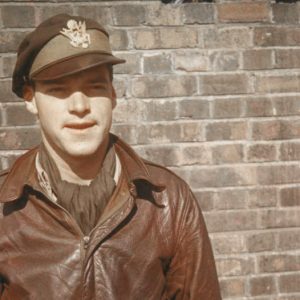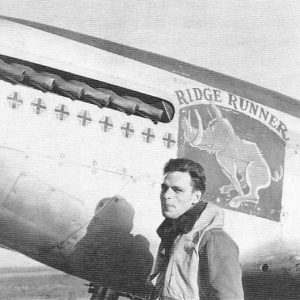calsfoundation@cals.org
Pierce Winningham “Mac” McKennon (1919–1947)
Pierce Winningham “Mac” McKennon was a talented musician but is more widely remembered as a famous World War II flying ace. He destroyed twenty German aircraft and earned the Distinguished Flying Cross with four clusters, the Air Medal with sixteen clusters, the Purple Heart, the Distinguished Unit Citation, and the Croix de Guerre.
Pierce McKennon was born in Clarksville (Johnson County) on November 30, 1919, to Dr. Parma D. McKennon, who was a dentist, and Inez Winningham McKennon. He had two older brothers. The family moved to Fort Smith (Sebastian County) in 1921.
He graduated from St. Anne’s Academy in Fort Smith and entered the University of Arkansas (UA) in Fayetteville (Washington County) on a music scholarship in 1937, but he left in 1938 after poor academic performance. He briefly returned to the university but never graduated.
In early 1941, McKennon entered the U.S. Army Air Corps aspiring to be a pilot but left for lack of aptitude. Undaunted, he went to Canada and joined the Royal Canadian Air Force (RCAF), excelling as an aviator and earning the rank of sergeant pilot in the RCAF by the end of 1941. McKennon became a member of an Eagle Squadron in Shropshire, England, and practiced throughout 1942 with a Royal Air Force (RAF) training unit. He transferred to the United States Army Air Force on November 24, 1942, and entered with the rank of second lieutenant.
McKennon was assigned to the Sixth Fighter Wing of the Eighth Air Force but was soon attached to 335th Fighter Squadron of the Fourth Fighter Group at Debden Air Base outside London. McKennon shot down four enemy aircraft while flying his P-47 Thunderbolt and then switched to the P-51 Mustang, in which in 1944, he downed a fifth enemy plane and earned his designation as an ace. McKennon subsequently served as flight commander and destroyed several other enemy aircraft.
After a promotion to captain, McKennon became commander of the 335th Fighter Squadron. On August 28, 1944, he was shot down behind enemy lines in France but was smuggled back to England with the aid of the French underground. After a promotion to major in 1945, he was shot down again, this time near Berlin, Germany. His wing man, Lieutenant George Green, picked him up in a field, and they both rode in Green’s plane back to Debden. McKennon again became a target for German fire and was wounded but managed to return his plane to safety.
McKennon stayed in Europe with the army of occupation until April 1946. He returned to the United States and served as instructor for fighter aircraft at both Luke and Williams Fields in Arizona and later at Randolph Field in Texas. McKennon married Beulah Irene Sawyer of Fort Smith on May 13, 1946, and the couple had one son.
McKennon was killed in a training accident on June 18, 1947, when he and a student pilot crashed near San Antonio, Texas. McKennon is buried in Forest Park Cemetery in Fort Smith. McKennon was inducted into the Arkansas Aviation Hall of Fame in 1985.
For additional information:
“Fort Smith War Hero Dies in Crash.” Arkansas Gazette, June 19, 1947, p. 1.
Hudson, James J. “Major Pierce McKennon: Arkansas’ ‘Boogie Woogie’ Playing Air Ace.” Arkansas Historical Quarterly 23 (Spring 1964): 3–35.
———. “The Piggy-Back Rescue.” Aerospace Historian 17, nos. 2–3 (1970): 69–71.
Brenda J. Murray
Russellville, Arkansas
 Aviation
Aviation Pierce McKennon
Pierce McKennon  Pierce McKennon
Pierce McKennon  Pierce McKennon in the Cockpit
Pierce McKennon in the Cockpit 



Comments
No comments on this entry yet.